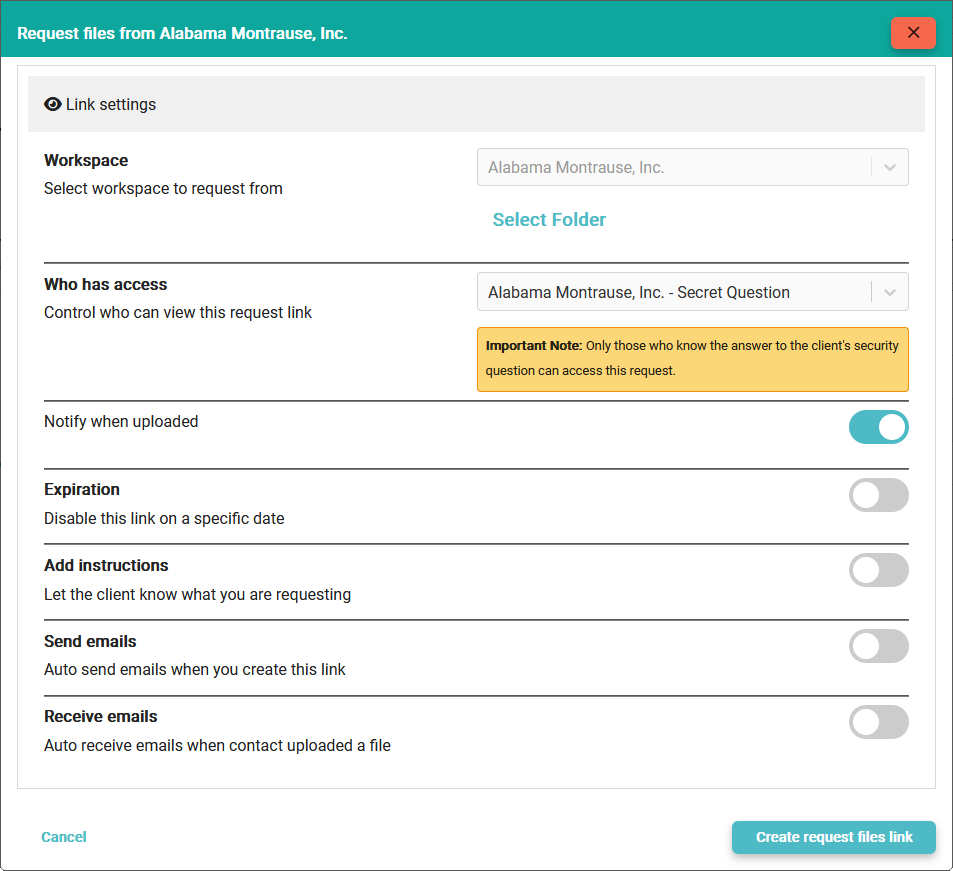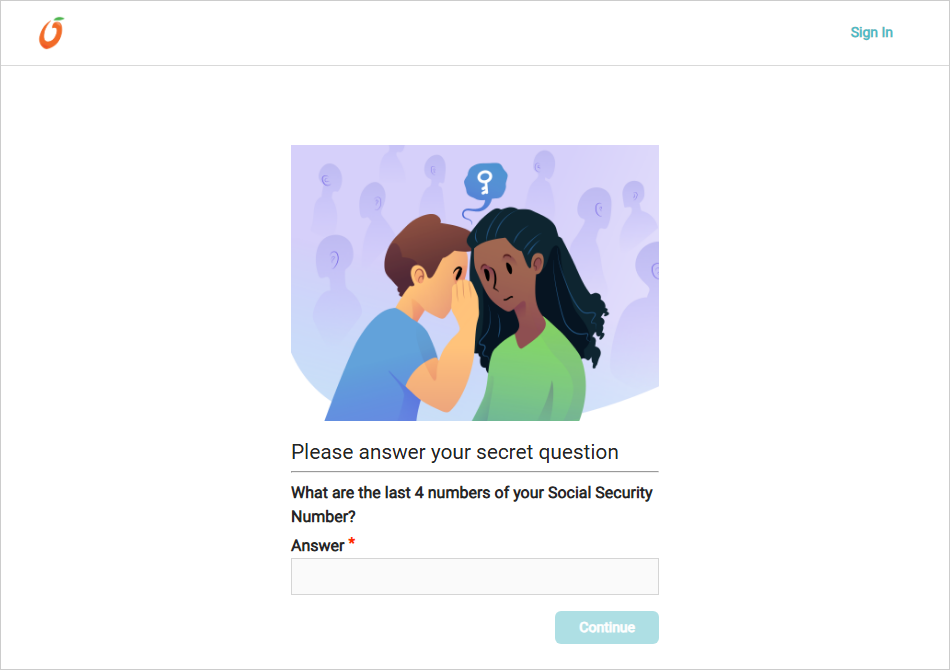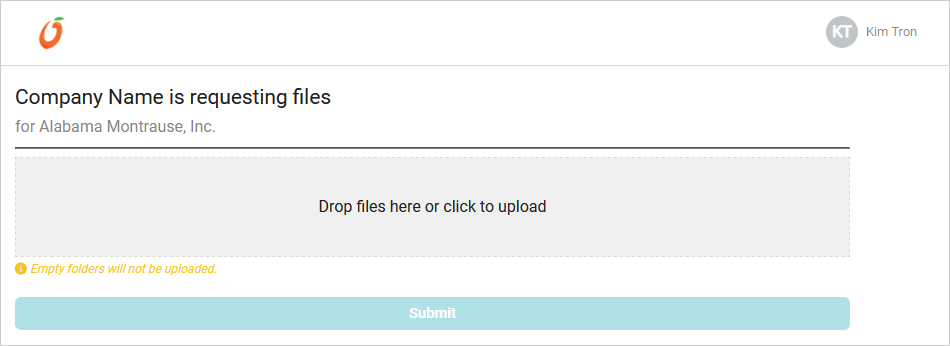Requesting Files
November 25, 2024
MangoShare’s easy file sharing service allows you to request files from a client, and then access them immediately. You don’t need to wait for important documents in the mail, or to have a client visit your office. Unlike other file sharing services (or even many client portals), MangoShare allows you to receive any type of file by providing your clients the ability to upload electronically via email.
Sending a File Request
You can share a file from throughout MangoShare, anywhere a folder or workspace is accessible.
The Request Files option is used to request a client or other party provide one or more documents to the firm. The recipient is provided a secure link to upload the files to the MangoShare servers.

To send a file request
- Click the New Link button, and then click Request files.
- Select the Workspace for the request. If this request is not related to a client, you can select the General Files or Staff Files workspace. When making this request from a specific workspace, this field will be disabled.
- Optionally click Select Folder and choose a folder in the workspace. Click New Folder to create a folder in the workspace. Once a folder is selected, click Save.
- Specify Who has access to the file (Direct Link, Question/Answer, or a Secret Question associated with the client or contact). The default value for this field depends on the Default Authentication Scheme for Links option on the Advanced Settings tab of Firm Settings. This field may be disabled if the Allow Users to change default authentication scheme option is disabled on the Advanced Settings tab of Firm Settings.
- If Question/Answer is selected, select a Question and enter a Shared answer. The list of questions for the Question/Answer option can be configured on the Advanced Settings tab of Firm Settings.
- If a Secret Question is associated with the client or any contact, select which secret question to use. The Secret Question for a client can be configured on the Overview tab of the Workspace Detail, and the Secret Question for a contact can be configured on the Personal Info tab of the Contact pane. For additional information, see the Advanced Settings, Workspace Details, and Contacts articles.
- Optionally select Notify when uploaded to send a notification to assigned staff when the requested file is uploaded.
- Optionally specify an Expiration. Depending on the Expire Request File Links Automatically after (Days) option on the Advanced Settings tab of Firm Settings, the link may have a default expiration. For additional information, see the Advanced Settings article.
- To add a message to the recipient, select Add instructions and enter information in the Instructions field.
- To send the email, select Send emails and specify the recipient(s) and message. If you prefer to send the email yourself, a link will be generated regardless of this setting.
- To send a copy of the message to yourself or another staff member, select Receive emails.
- Click Create request files link. The link will be generated and, if selected, an email will be sent automatically.
Using a Request List
File requests can also be created for multiple workspaces simultaneously using request lists. This allows you to request similar information for many clients, such as tax documents required at the beginning of the year.

For information on creating request lists, see the Request Lists article.
To assign a request list
- Click
 Workspaces.
Workspaces. - Select the client workspace(s) to assign the request list.
- Click Apply Template, and then select Apply Request List.
- Click Select request list, pick the request list, and click Done.
- Click Apply Template.
To publish the request list tasks
- Click the Workspace Name column to open the workspace details.
- Click the Request Lists
- Click the Name column to open the request list.
- Select the task(s).
- Click Publish.
Accessing a File Request
Recipients will receive an email with a MangoShare link. After clicking the link, a file link recipient opens a page containing a file upload area where they can upload the requested file(s). This page is similar to the portal; however, unlike the portal, a recipient does not need to log in, and does not have access to any other files or pages. They only have access to the file directly related to the request.
Enter Your Name
The recipient will be prompted to enter their name and email address. Once entered, click Done.

Secret Question
When using the Secret Question link option, the recipient will be prompted to enter the Answer to the selected question. Once entered, click Continue.

Requested Files
When opening a file request link, a file upload area is shown. Recipients can drag and drop or click to select files, and then click Submit to upload the files to the MangoShare servers.

Common Questions About Requesting Files
- What document types can we request?
- Any type of file can be requested from your client.
- A client wants to receive notifications as soon as new files are available. Can MangoShare do this?
- Yes, contacts associated to a client workspace can optionally receive notifications when a file is uploaded, viewed, downloaded, or commented on. To add a contact to a client in MangoShare, use the following steps:
- Click Workspaces.
- Click the name of the client.
- On the Contacts tab, click Add Contacts.
- Enter the Email Address and Full Name of the contact.
- Optionally Add a Personal Note to the invitation email.
- Click Invite contact.
- On the Notifications tab, enable or disable the desired options in the Contacts will receive a notification when you
To change notifications sent to an existing contact, click the Notifications tab in Workspaces, then enable or disable the desired options in the Contacts will receive a notification when you section.
- Can I get notifications when my client interacts with a file in MangoShare?
- Yes, assigned staff can optionally receive notifications when a file is uploaded, viewed, downloaded, commented on, or signed by a contact. To assign staff to a client in MangoShare, use the following steps:
- Click Workspaces.
- Click the name of the client.
- On the Assigned Staff tab, click Assign staff members.
- Select your name and any other staff members who should receive notifications for this client, and then click Next.
- Enable or disable the desired options in the Assigned staffs will receive a notification when contacts section, and then click Continue assigning.
To change notifications sent to a currently assigned staff member, click the Notifications tab in Workspaces, then enable or disable the desired options in the You will receive a notification when you section.
- My client did not receive the request from MangoShare, or it was marked as spam. What can we do to prevent this?
- Occasionally, email messages coming from MangoShare are incorrectly marked as spam. To make sure they are delivered, have your clients whitelist “no-reply@MangoShare.io” in their email application. Use the following steps to do this using Microsoft Outlook:
- Right-click in your email list, point to Junk, and select Junk E-mail Options.
- On the Safe Senders tab, click Add.
- Enter “no-reply@MangoShare.io” and click OK.
- Click OK to close the Junk Email Options window.
If they use another email application, or if their email is filtered by their service, they may need to contact their email provider for steps to whitelist email addresses.
- I received the message “JavaScript Alert – There was a problem creating the shareLink.” What does this mean?
- This message can be shown when sending a Request Files link using a Question/Answer, but no Shared answer is specified. Attempt to send the request again with a valid answer. If this issue persists, contact MangoShare Support.
- One of our recipients received the message, “Whoops! This link is expired.” What does this mean?
- This message can occur when a recipient clicks on a file link, but the Workspace in MangoShare has been deleted. Deleting a Workspace is not recommended. If a Workspace was deleted in error, contact MangoShare Support.
See It in Action
Learn More
The following knowledge base articles contain additional information relating to Requesting Files: